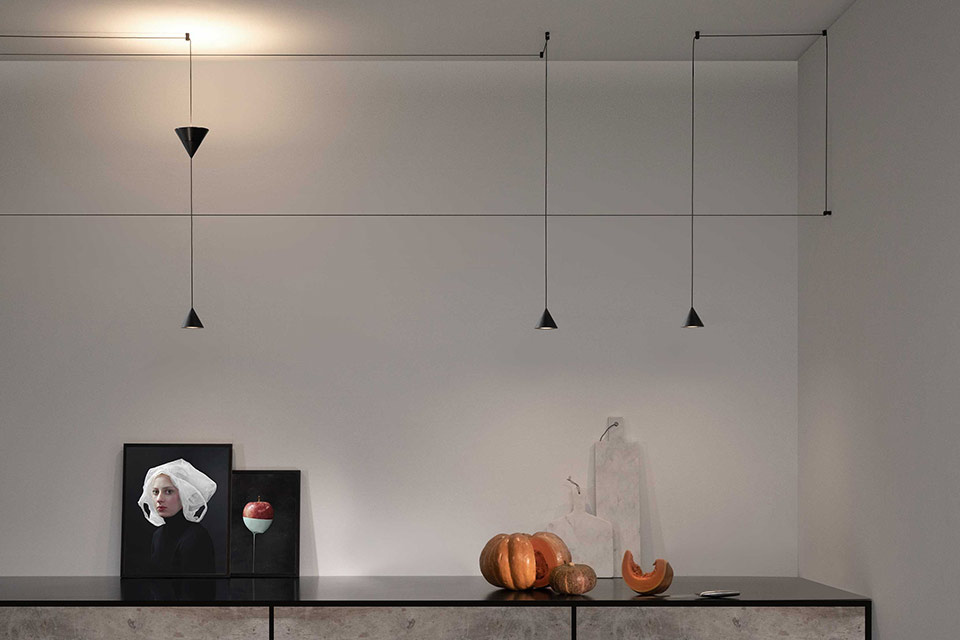Correct office lighting affects style, productivity, and well-being. Read the article to discover 6 ideas that combine technique and design.
Lighting plays a particularly delicate role in work environments, where the main goal is to create a pleasant and productive atmosphere, as well as a strongly identifiable composition.
Insufficient or blinding light, overly general lighting that does not consider different functional areas, or an inconsistent color temperature. These are just a few of the mistakes that architects and interior designers can make when lighting an office.
In this article, we will provide 6 tips for combining style and performance to achieve a flawless final result.
- 6 ideas to combine elegance and functionality in the office
- Why is it important to consider natural light sources?
- Evaluate the systems best suited to the furnishing concept
- How to choose lighting sources with the right color temperature?
- How to ensure light is evenly distributed throughout the space?
- How to guarantee functional light points at the workstation?
- Why introduce accent lighting in the office?
- How to ensure visual comfort with Karman lights?

Stant
6 Ideas to Combine Elegance and Functionality in the Office
As interior lighting designers teach, office lighting plays a decisive role in visual comfort, concentration, and space perception.
Those who will live in these environments daily must feel comfortable, surrounded by a relaxing yet stimulating atmosphere, to promote collaboration and productivity.
To make this possible, it is essential to consider a variety of factors. Starting with the fact that it’s not enough to have visually impactful lighting but also not just a purely functional light, rather it’s necessary to find a balance between the two.
Effective office lighting should convey the corporate identity while fully serving its practical function.
To ensure that these requirements are equally met, it is necessary to follow some design criteria, which we have summarized in the 6 guidelines below.
Why is it important to consider natural light sources?
First of all, it is important to assess the potential for natural brightness in the room and the main paths for sunlight entry.
This will influence the arrangement of desks and workstations, as well as the number and positioning of the different lighting sources to be installed in the office.
Remember, artificial lighting should complement natural light, not the other way around. In this regard, natural light is the foundation of visual comfort and impacts psychological well-being and circadian rhythms.
In office lighting, a careful analysis of how sunlight behaves at different times of the day allows you to make the most of natural light exposure. This, in turn, reduces the need for intense and continuous artificial lighting, enhancing visual and psychological comfort.
Also, don't forget the advantages in terms of sustainability and energy efficiency, which are increasingly central to contemporary workspace design.

Filomena
Evaluate the systems best suited to the furnishing concept
The second step in designing office lighting is to select the lighting models that best fit the context.
Light is an important tool for communicating corporate identity, and it is essential that it is consistent with the overall mood and layout.
The winning combination, as we remind you, is one that harmoniously blends technical and decorative lighting without compromising performance or visual identity.
In this regard, lighting systems are particularly suited for office lighting, offering maximum compositional freedom. Here are some Karman proposals to inspire you:
- The Airtek One Collection expresses a minimal, highly functional light that can freely articulate within the space.
- The Turn It Collection, with its modular and configurable structure, allows for infinite configurations for any design need.
- The Stant Collection, through its straight and curved lines in white or black painted aluminum, allows for the design of light micro-architectures, either suspended or ceiling-mounted.
- The Filomena Collection is a system of suspensions and appliques that can span walls and ceilings according to technical and aesthetic needs.
In all of these Karman systems, light becomes a true tool in the designer's hands. Not just lamps that illuminate and decorate, but solutions that allow the office environment to be organized, defining its rhythm and narrative.
Each with its own unique and distinctive aesthetic language, they demonstrate that it is possible to be minimalist and prefer clean lines and shapes without falling into anonymity. And it is precisely this characteristic, combined with extreme modularity, that makes them perfect for office lighting.

Turn It
How to choose lighting sources with the right color temperature?
The office environment, on the other hand, requires a more energetic and stimulating atmosphere, and for this reason, a higher color temperature is definitely more suitable.
Therefore, with the exception of areas such as a relaxation space, the recommendation is to prefer white light sources, from neutral (3500-4000K) to cool (5000-6500K).
It is clear that each project should be evaluated in its specificity, considering, for example, the colors and materials chosen for the furniture.
Finally, besides a careful choice of color temperature, it is important to opt for a high CRI - Color Rendering Index, which for office lighting should be ≥90.

Airtek
How to ensure that light is evenly distributed throughout the space?
An office space should be illuminated as evenly as possible, without shadows or harsh light contrasts.
To ensure good ambient lighting, it is important to select lamps that provide the entire space with bright, homogeneous, and well-distributed light.
To achieve this goal, the designer must plan for multiple levels of lighting, starting with the so-called “ambient lighting.”
Also known as “general lighting,” ambient light radiates a comfortable level of brightness without glare, providing visual comfort and allowing for free and safe movement.
What is important to emphasize is that a diffused light is not the result of a few powerful lamps, but rather of a network of light points carefully distributed. For example, considering indirect light sources that reflect light on the ceiling and walls creates a uniform effect without glare.
Modular systems, like the ones we've shown, are very suitable for office lighting because they can cover large spaces as well.

Filomena
How to guarantee functional light points at the workstation?
We’ve just talked about general lighting. Another crucial level of lighting for an office is task lighting.
This type of lighting helps perform specific activities like reading, writing, and working. The goal, in this case, is to design a light that is free of reflections and distracting shadows and bright enough to prevent eye strain.
Therefore, it is important that each workstation has its own dedicated light source, punctual and uniform, that provides the desk with an average illumination of at least 500 lux. This value may increase to 750-1000 lux for high-precision tasks.
The light source, which could be a desk lamp or a floor lamp, should be positioned laterally to the dominant hand and slightly off-center.
One of the most interesting and widely used innovations in new-generation offices is “daylight harvesting” systems. These are technologies that detect the amount of natural light in real-time and adjust the intensity of artificial light accordingly.

Turn It
Why introduce accent lighting in the office?
The third level of lighting, accent lighting, is often overlooked in workplace lighting.
Yet it is essential when you want to elevate the office space beyond simple functionality, as accent lighting adds drama to details in a room, creating visual interest.
In fact, accent lighting sources are used to draw attention to decorative elements, architectural details, plants, paintings, sculptures, and personal/professional items like diplomas, degrees, certificates, etc.
It can also be used to highlight the texture of a brick or stone wall, window treatments, or the external landscape.
Through accent lighting, it is possible to define the identity, atmosphere, and perception that the brand wants to convey. It also helps break up the visual monotony that often characterizes workspaces.
It should be noted that for accent lighting to be effective, it needs at least three times the light on the focal point compared to the general lighting surrounding it.
How to ensure visual comfort with Karman lights?
We've seen how correct office lighting is absolutely fundamental in terms of visual comfort, space perception, and interior design.
Light influences our senses and changes the perception of the office space's atmosphere, mood, and the concentration of those working within it.
In this context, Karman lamps serve as genuine design tools, capable not only of creating a luminous set but also structuring the space. On one hand, they ensure a strong formal presence, and on the other, that essential lighting quality, especially in work environments.
It is precisely from this combination that it is possible to design offices that are comfortable to live and work in, with both the eyes and the senses.
The breadth of the catalog also allows professionals to identify the most suitable lighting installations for their projects and build the various lighting layers discussed.
For more information, support, and assistance in selecting the right lamp models for your office lighting project, feel free to contact us. We are at your full disposal.




